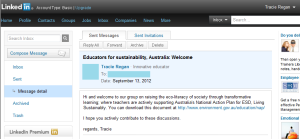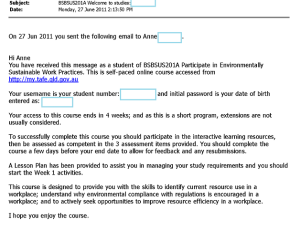Is it just me or is there a general lack of etiquette with e-learning? I see all sorts of course Announcements starting with ‘Your assessments are NOW DUE!’ and think ‘how rude!’

If you entered a classroom, you would start by introducing yourself. This is also easy to do in an online environment and you can even save your recording as a podcast like this one:
http://audioboo.fm/boos/693235-deewr-efs-qld-2012-welcome
 Most learning management systems also have instant messaging service; where you can see who is online at the same time as you. It’s not much effort to type ‘Hi, I’m online too – can I help you?‘
Most learning management systems also have instant messaging service; where you can see who is online at the same time as you. It’s not much effort to type ‘Hi, I’m online too – can I help you?‘
Setting rules for the online classroom is just as important as in the face to face setting. Here is a link to my slideshare presentation that gives you a starting point for this conversation.
Some examples of welcome messages I send are:
* new LinkedIn members of the group I manage:
or for a new online class member (note I have cropped my contact details at the end to limit spam):
So, when you develop your messages for online participation remember to:
- Inform the recipient of the intention of the message – are you sending instructions on accessing their new studies, reminding them of assessment due dates, or providing general information?
- Explain what you want the person to do next – review their lesson plan, completion an orientation, do the ice-breaker activity…
- Provide a deadline for this next step, but in a passive voice – ‘before next week can you.,,‘; ‘your access to this course ends in 4 weeks…‘; ‘this group will be open for collaborative discussions until May…‘
- Provide a ‘phone a friend’ option – ‘call me on 555-xxx if you need help’
- Be respectful – you don’t know if the person you are sending this message to is having a personal crisis unrelated to your intention and ‘do this before tomorrow or you fail’ might push them over their limits.
- Follow through – there is no point in saying you will be available if you turn off your phone, nor if you have set boundaries but let them be ignored.
See, it’s not so different to person to person politeness.

image sourced from http://free.clipartof.com/pg2
Possibly a Post-script for this post is a reminder of using the appropriate tool for the intention of the message.
- Use Announcements for broadcast messages you might typically hear using a loud speaker system in real life. An example would be ‘QLD training Awards now open!‘
- Use group emails for group discussions; such as ‘You have received this as a member of xxx; most of you are on track now for your final assessments – well done!‘
- Use personal emails for recording personal discussions for later evidence of student interaction and participation – ‘Hi Anne, thanks for working through the first topic with me today by phone. You have shown a sound understanding of these concepts for the unit BSBFIM501A Manage Finance and Budgets. You should now be ready to attempt your first assessment. Please complete this before the end of the month.‘
- Use instant message or chat areas for informal discussions – ‘Hi Anne – need any help? I see you have started Topic 1. I can call you if you want to work through this together’


